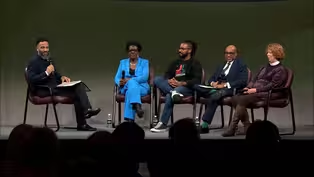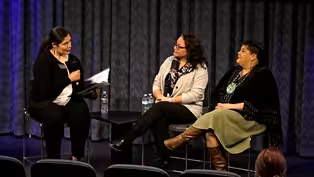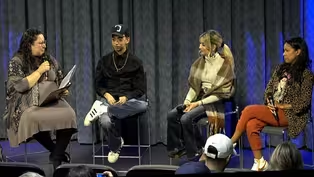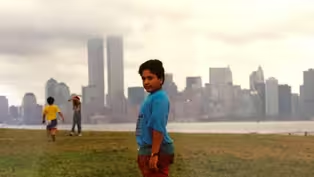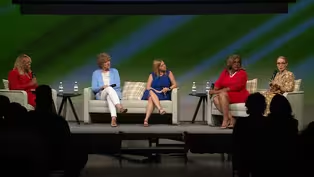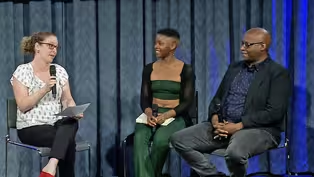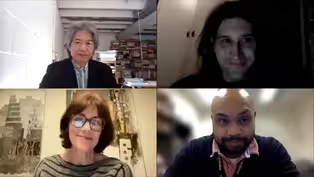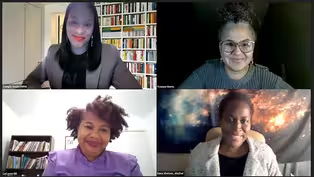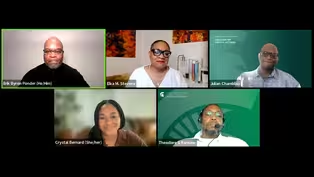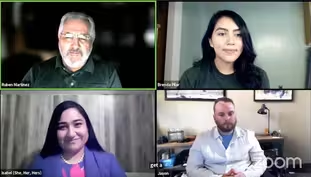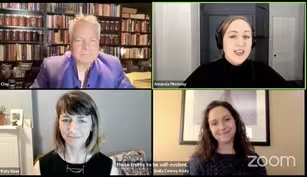
Panel Q & A – NOVA Science Studio Showcase
Special | 53m 35sVideo has Closed Captions
WKAR showcases highlights from the NOVA Science Studio project.
WKAR showcases highlights from the NOVA Science Studio project. In 2022-2023, WKAR worked with colleagues at NOVA and with students at mid-Michigan high schools to create programming around environmental issues. WKAR storytellers Nicole Zaremba and Bobby Taylor offer insights into the process of investigating the issues and crafting the video reports. Hosted by WKAR's Al Martin. Recorded 6/22/23.
Problems playing video? | Closed Captioning Feedback
Problems playing video? | Closed Captioning Feedback
WKAR Specials is a local public television program presented by WKAR
Major funding for NOVA Science Studio is provided by the Corporation for Public Broadcasting.

Panel Q & A – NOVA Science Studio Showcase
Special | 53m 35sVideo has Closed Captions
WKAR showcases highlights from the NOVA Science Studio project. In 2022-2023, WKAR worked with colleagues at NOVA and with students at mid-Michigan high schools to create programming around environmental issues. WKAR storytellers Nicole Zaremba and Bobby Taylor offer insights into the process of investigating the issues and crafting the video reports. Hosted by WKAR's Al Martin. Recorded 6/22/23.
Problems playing video? | Closed Captioning Feedback
How to Watch WKAR Specials
WKAR Specials is available to stream on pbs.org and the free PBS App, available on iPhone, Apple TV, Android TV, Android smartphones, Amazon Fire TV, Amazon Fire Tablet, Roku, Samsung Smart TV, and Vizio.
More from This Collection
Panel discussions following WKAR film screenings. Featuring filmmakers, policy makers, community partners and more.
Panel Q & A - The Cost of Inheritance
Video has Closed Captions
Panel discussion following the film The Cost of Inheritance. (30m 59s)
Video has Closed Captions
Panel discussion following the film Warrior Lawyers. (33m 42s)
Panel Q & A – First Voice Generation
Video has Closed Captions
Panel discussion following the film First Voice Generation. (31m 2s)
Video has Closed Captions
Panel following the film "American Jedi." Discussion features the film’s producers. (48m 46s)
Panel Q & A – Building the Reading Brain
Video has Closed Captions
Panel discussion following the WKAR original film, Building the Reading Brain. (36m)
Video has Closed Captions
Panel discussion following the film Afrofantastic. Featuring filmmaker Julian Chambliss (29m 6s)
Panel Q & A – Free Chol Soo Lee
Video has Closed Captions
Panel discussion following the film Free Chol Soo Lee. (29m 48s)
Panel Q & A - Storming Caesars Palace
Video has Closed Captions
Panel discussion following the film Storming Caesars Palace (25m 19s)
Video has Closed Captions
Panel discussion following the episode Afrofuturism, from the Artbound series (33m 56s)
Panel Q&A - Brenda's Story: From Undocumented to Documented
Video has Closed Captions
Panel discussion following the film Brenda's Story (25m 44s)
Panel Q & A - Benjamin Franklin
Video has Closed Captions
Panel discussion following the film Benjamin Franklin. (21m 46s)
Video has Closed Captions
Panel discussion following the film Unadopted. (31m 45s)
Providing Support for PBS.org
Learn Moreabout PBS online sponsorshipHello.
I'm Al Martin.
I am a reporter here at WKAR and host and I'm glad you could join us tonight for the Nova Science Studio Video Showcase.
Give it up for that, guys.
Yes.
It is going to be a very fun and enlightening and entertaining night for sure.
And a few housekeeping notes.
I hope you guys have been enjoying the light refreshments available in the hall.
You will notice pencils and pieces of paper on your chairs.
You should notice that by now.
Right.
And I will let you guys know that during our conversations this evening, please feel free to write down any questions that you might have for our outstanding panelist.
So just keep that in mind.
Emily and Bill will collect them and bring them up to us at the end of our panel discussion.
And please keep your questions.
I want to stress this.
Please keep your questions pertinent to production process and creation content.
All right.
So we're going to focus on how these pieces were made and not necessarily the content that they're highlighting.
All right.
Now, as you may know, Nova is one of PBS's most widely distributed science programs in the world with multimedia and multi-platform options accessible across America.
Nova provides educators and the general populace with accurate and engaging scientific topics ranging from planet Earth to tech and engineering to even ancient worlds.
Very cool.
Now, WKAR has been collaborating with NOVA on various projects dating back to 2017.
Most recently, a project called Weathering the Future.
I want to focus on that because we're talking about two hour long specials from our colleagues at NOVA, a special report produced by our fantastic team here at WKAR and Science Studio.
This is very cool guidance of our professional storytellers here at WKAR that encompasses 35 students from three area high schools, produced own video reports on environmental issues in their local communities.
In all, the students created 12 outstanding pieces.
Can we give a round of applause for that very, very cool stuff?
And tonight, check this.
We are going to sample those videos from the national to the hyperlocal and explore the creative process that these storytellers went through.
So I want to begin right now with a sample of the hour long specials produced by Nova.
So a historic event in itself.
I have been so surprised to see these monsters on the air saying, look at this thing.
Look at what this hurricane is doing.
As our weather becomes.
More extreme, the hotter gets the dryer, gets the dryer it gets, the hotter it gets.
The weather is wacko.
This is a system shift.
Water becomes scarce.
This is one of the main sources of drinking water.
There's hardly any water in it.
Storms become.
Stronger.
The rain now comes.
A lot angrier.
30 or 40 mile an hour wind howls for days on end and homes are destroyed.
We had the types of fires that humans simply can't stop.
Extreme weather is taking its toll.
As the storms get stronger, as we lose more land.
You lose a piece of who you are.
But across the country, many are fighting back.
This is my home.
We're not going anywhere.
By innovating solutions, we can substantially cool down cities without major expenditures.
Marshaling ancient.
Wisdom.
We're setting the landscape on a trajectory to accept fire in a good way.
It's worked for 10,000 years.
It can work again.
And visionary.
Ideas.
There's nothing we can do if we use all the technology available to us.
We know what needs to be done.
We just have to have the will to act and do it.
Weathering the Future on Nova.
What would it take?
We need our electricity to be zero carbon.
To cut emissions to zero.
It's not just about designing something.
You've got to figure out how to build it.
This is something that just a few years ago was considered impossible.
Chasing Carbon Zero on Nova.
Outstanding now.
Weathering the Future and Chasing Carbon Zero actually aired in April.
And you can watch those four episodes right now for free streaming in the free PBS video app.
Now, climate change is global, but its effects are felt locally.
The studio The Science Studio Project was created by Nova to tell those local stories.
Over the past year, students from three mid-Michigan high schools gained hands on experience in environmental journalism, reporting on local stories that bring home issues, raised in the NOVA specials.
Now, without further ado, it is my pleasure to introduce Robert Taylor or Bobby, as he prefers.
As WKAR Science Studio Coordinator, he served as mentor to students from Sexton, Ovid-Elsie and Davison high schools.
The end result 12 video reports all online now as part of the Nova Science Studio Project.
I now give you and please give me a round of applause.
Bobby Taylor.
Thank you.
And as Al mentioned, I'm Bobby Taylor generally here at WKAR.
My title is Television Production Technician.
So really that's just a way of saying that I help out in all things related production.
I wear a camera for a lot of things, kind of like what's going on in here, which fortunately today we have some of our great student interns that are helping out.
But I do camera operations.
I edit a lot of our original programing.
And then I also do a lot of, in recent times, community outreach with like career fairs and things like that and events that we have here at WKAR.
So with the site coordinator position, as Al mentioned also, I went to all three of these schools in the area.
So Davison High School, Ovid-Elsie High School and Sexton right here in Lansing to help them sort of from the beginning come up with the concepts of what they wanted to talk about as it relates to climate change and then go through the entire process of researching our topics, finding experts to interview, and then go through the full production process of learning how to light a set to miking someone and what camera settings we should go through and how we should ed our videos and what we should, how we should ed videos for certain platforms like for Internet and for social media.
So the first school that I want to talk about is Davison High School, Davison High School had the largest group of all the students.
Their first video that I'm gonna show here is about packaging waste.
So this is, again, solely their idea, completely done by the students with guidance from myself and from the instructors there at Davison.
Online shopping has boomed in popularity over the past 30 years, but it's not the shopping that's the problem.
It's all of the extra packaging we get with it.
It usually comes in like a box and another.
Box, like something wrapped up in it.
And sometimes it's not.
Necessary, like four boxes for one pair of shoes.
A survey from Pew Research Center found that nearly 80% of Americans shop online with all the shopping.
Packaging waste from materials such as cardboard, plastics and Styrofoam have become harder to recycle since it's now delivered to individual homes, as opposed to being one big shipment to the store.
A study from World Economic Forum explains that only 16% of plastic actually makes it into the recycling plant.
The other 84% that does not make it into the plant has a possibility to end up in our rivers and oceans.
Once plastic is dumped into the water, it releases greenhouse gases as it slowly breaks down, which send more carbon emissions into our air.
Not only does the plastic release greenhouse gases contributing to climate change, but so do the delivery trucks for all these packages.
Rafael Oras is a professor at MSU School of Packaging and is working on the issue of packaging that cannot be biodegradable.
When the waste go to their houses.
It's a little more challenge because you need to have all these communities now collecting those materials.
And then we have communities in Michigan, for example, that do not have the collection.
Then the material will not be recovered.
A study from Sustainable Packaging Coalition says that roughly 60% of U.S. citizens have access to curbside recycling.
But when packages are sent to your home, it often ends up here on the side of the road or just sitting in landfills.
The transportation of goods and the materials used to package them both contribute to climate change.
And this is accelerated when the excess waste is left in places where it shouldn't be.
Rafael and many students at MSU have researched ways to degrade materials in a more efficient way to lower the amount of plastic left behind in the environment.
But they compost process using heat and soil.
In these jars we have a compost soil and we introduce the materials inside.
And then that material we produce air and then look at how the material will degrade function of time by a simulated that process to happen in industrial composting operation.
All right, let's hear it for the group at Davison that did packaging waste.
So Davison High School again was one of the larger it was the largest of the three schools.
They actually ran this program among two different classes.
So they had their upperclassmen that work their normal production class.
They do a newscast four days a week there.
So they tried to squeeze in the Nova curriculum twice a week.
So for about an hour a week, every day or every I'm sorry, every week, twice a week they came up with six different video topics.
So we just saw packaging waste.
They also came across paper waste, food waste.
They talked about how climate change is affecting cherries and cherry production in Michigan.
They also talked about invasive species in the Asian carp that are coming into the Great Lakes.
And they also even went a lot bigger than that and decided to discuss the Great Lakes being a main source of freshwater in the U.S. and how that can help drought throughout the country.
So although a lot of our schools focused on things that were immediately local at their school, Davison also took this as a chance to do a little bit more investigative journalism and had some of the resources to be able to go out and go to the Great Lakes.
They interviewed a boat captain who works at a fishery out there, got to take a day out on the lake and also went out on the boat with them.
I encourage everyone I'll say this repeatedly, but I encourage everyone to follow through with these videos and watch them online on YouTube as as all mentioned, they are posted on our YouTube channel.
And Nova will also be promoting these throughout the week.
So my next school that I want to talk about is over Elsie.
Over.
Elsie was in a little bit more of a rural area and their stories were more focused along that as it affected those students directly.
So the story that we're going to preview right now with over Elsie is about organic farming.
There are ways to mitigate greenhouse gases in agriculture.
Organic farmers can achieve this by using organic farming techniques rather than conventional to reduce carbon emissions.
One of the major benefits of organic farming is its lower carbon footprint.
A carbon footprint is how much carbon one is emitting into the atmosphere and comparison to conventional farming.
Organic farming releases much less carbon into the atmosphere through its techniques.
There's more carbon sequestration, meaning that there is less carbon being emitted into the environment.
Katie Bryant, program manager for the Michigan State University Organic Farming Program, mentions multiple techniques on how organic lowers our carbon footprint.
Although there are many techniques in organic farming that can achieve this.
A couple that Brad discusses are cover cropping and composting.
Fixing cover crop is going to be at zero almost zero carbon footprint, producing nitrogen onsite through the power of plants.
Nitrogen fixing cover crops.
Reduce the amount of carbon by sequestering it in the soil.
Brand discusses another important aspect to keep the carbon footprint low.
Composting whether you're doing this in your backyard or whether this is happening on a farm scale, compost is taking food, waste or manure, and instead of that breaking down without oxygen and turning into climate gases, essentially methane and many others, and it's turning it into a resource.
Right.
So we're taking this problem and turning it into a solution.
All right.
Let's hear it for the students at Ovid, Elsie High School.
So now a little bit, just about Ovid, Elsie, their program was much smaller.
They had about nine students in total.
So as you can see, they had three stories.
They talked about water treatment plants and plans to make those more friendly for the environment.
They talked about organic farming and then also the transition to solar energy and how that can save money and also the planet.
So with these three stories and nine students, they were assigned three students per video.
So a lot of students were kind of going into endeavors that they hadn't really planned with a few of them even acting out a little bit in their in their videos.
Again, I very much encourage you to go and watch these afterwards.
I will say that after every snippet that I play, one of the good things that nobody else and I'll share that a lot of my trips out to their site.
I was out there every other week for the most part across the entire school year, starting back in September.
So every two weeks, every three weeks, we would generally talk about what it was like working in production and how a lot of those students wanted to continue to work in production after they are done with their classes and once they go on either in school or not in school.
And one of the things that they had done during their their program, which I'm just going to give a little props to here, I won't give too many details.
They decided to make a commercial sort of as a just as a practice thing as part of their class.
Well, it was for a local business here in the Lansing area.
And word got to them through social media and that local business actually is planning on hiring those students to then continue to make commercials for them in the future.
So there's a proud instructor moment that I got to be a part of that was really cool to see a lot of those students learning production for the first time and then also where it kind of took them and where they ended towards the end of the school year.
So the last school I'm going to talk about is sex in high school, which is here in the Lansing area.
Sex in high school did not have a media production program.
The kids that joined the Nova Science Studio project were all students that joined because they were interested in the science aspect of it.
So it was SCI, a science club after school on Mondays and Wednesdays.
So these students came on their own time after school to learn more about climate change, but then ultimately to make these videos by the end of the year.
So that group consisted of about nine students as well.
That kind of really stuck to about a core five group.
And the video that we're going to show off right now, again, these are all topics that they came up with by themselves.
This one is about goose poop and how goose poop affects the environment.
Like many birds, Canada geese have changed their migration patterns due to today's climate.
This has led to more geese in in Michigan for longer than ever.
Now, geese aren't necessarily the problem here.
Even though we can agree that geese they can be mean.
Their poop is.
That's right.
We're talking about your favorite subject, goose poop.
We sat down and spoke Beth Clawson from MSU Extension to discuss that.
Interesting connections between Goose Group and climate change.
I'm Dane.
I'm Brian.
What's your name?
My name is Beth Claussen, and I'm with Michigan State University Extension.
So does Goose Troop pose any direct problem or issue with the local environment in Michigan?
Yes, Canada goose poop does.
Pose a problem with the local environment.
Wherever they are.
Congregate the geese because it's warmer.
Now in parts of Michigan, they're not fly in much further south.
They're hanging around in Michigan.
And because it's not so cold, they're going to stay year round.
So even though geese are moving north, the geese that are south are moving to Michigan, their populations are staying the same in certain areas.
How does goose poop affect our vibe?
Goose poop has a big impact on our environment.
Canada geese can produce up to £1.5 of poop per goose per day, and so if you have 15 or more geese and they're producing £1.5 of poop per day.
That's a lot of poop.
All right.
And a round of applause for the students at Sex in.
So, like I mentioned before that video, the group at Sex and we're actually an after school club so they invested their own time that they dedicated to learning more about climate change and also kind of just barely getting their feet wet in the world of production, not really having any familiarity with it before the three topics that they had come up with were goose poop, climate change, anxiety, and what that means for teens.
And then also the possibility of snow days potentially going away.
And if that would mean heat days in Michigan.
So, Sexton, one of the things I love to brag about, about that site is that they're all ninth graders as well.
So they were the youngest group by far among all three sites.
Not to say that some of the other sites didn't have freshmen, but the core group of five students at Sexton that stuck through the end were all ninth graders that were also learning to do research papers in their normal classes.
And then they took that to the next step with these videos because as they're learning that simultaneously in their English courses, they're taking it immediately to their afterschool club, their after school science club.
So a very determined group, too, despite not having their own equipment or having their own program or even really having an instructor there other than myself.
And then the facilitator there, the instructor at Sexton, who was the science teacher, they really took it upon themselves to really learn production and learn how they would go about making these videos with reaching out to the experts, to interviewing them, and then also using their phones for some of the footage that you'll see in the videos.
So lastly, before I kind of wrap up, since there are so many videos and I can't show all 12 of them, I am going to show one more from Davison High School.
I touched on it a bit earlier, but this one is about the invasive species, the Asian carp in the Great Lakes.
This is one that, again, they had a lot of determination to make.
They were I think they took three trips out to the Great Lakes to actually record some of the footage that they have.
And then they also, in years prior, had done a documentary about the Great Lakes.
So they use a lot of their own archival footage to put this story together.
So this is the invasive species story.
The Asian carp are on the move.
These fish came from the Mississippi River and were found traveling north towards the Great Lakes via the Illinois River.
For anglers like Captain Todd Brill of the Gold Coast Fishing Charter Company, the Asian Carp is a major concern for their businesses.
We've created a $4.8 billion sport fishery on the Great Lakes, and without that, it would it would really hurt us.
So it's something definitely I take very serious.
The carp are an invasive species of no natural predators and they have been growing in the wild since the 1980s, since arriving from Southeast Asia in the Illinois River, they've already replaced 95% of the fish biomass, according to the National Wildlife Foundation.
As of June 2010, they have been found in Lake Calumet, just seven miles from Lake Michigan.
Dr. Peter Alsip is an ecological model data analyst in the University of Michigan's Cooperative Institute for Great Lakes Research.
He's been studying the invasive carp and their effect on the native species in the area, such as perch, lake trout and walleye.
These fish are what we call plank divers, so they eat algae and small microscopic organisms in the water column called Plankton.
The effects of Asian carp entering Lake Michigan could be catastrophic.
So why are the fish moving into these areas?
The Asian carp was introduced by other species natural resources, and they thrive in warmer waters due to better fitting their species.
Climate change only accelerates this migration according to climate that gov.
It's kind of a different environment than most of the lakes or these fish would probably do very well there.
So warm water tributaries we see in Michigan.
The Saint Joe is a very productive, warm water tributary.
Back in Saint Joseph, Captain Todd is worried about how the Asian carp would affect his company.
I run 20 miles north of Michigan's southern border.
Fishing companies like his and Lake Michigan could be victims to the invasive species.
When you talk to a lot of the the fishermen and stuff that around the Illinois River and some of these rivers where they have taken off, they haven't been able to adapt.
I mean, it's completely destroyed their fishery.
Captain Todd's business depends on salmon and trout, which would be killed if the Asian carp stripped their resources, leaving less food for native species.
All right, let's hear it one more time for David said and all the sites as they put together those awesome videos.
For me personally, this is a role that I never really consider it even being a thing, being sort of their instructor for all three sites, it's hard for me to choose four videos to play here and for all of you, which is why I will keep reiterating.
Please watch the rest of these videos at WJR on our YouTube channel.
But I will say that through all these sites, it was incredible to see the different topics and stories and things that these students came up with.
And you can see just from those four snippets how different their perspective of what climate change is and what it can be and how it affects them is all across the board, from goose poop to Asian carp in the Great Lakes.
So I couldn't be more proud of the videos that those students put out.
It was a great honor for me to be a part of all those videos and a lot of the connections of what Nicole is about to talk about here with some of our Nova pieces that we've worked on in our most recent piece.
A lot of these students went through the same production process, so I can talk more about that later, but for now, I'm going to pass it over.
Back to you, Allan.
Nicole.
One more time for Barbie and those incredible stories produced by the students.
Wow.
That's some great reporting experience for those students and some some really enlightening stories as well.
Okay.
Yes.
Nicole Zarembo is a producer and director here at WJR.
Recently, she directed the digital documentary Short The Future of TV Batteries as part of our Nova Climate Across America initiative.
Let's take a look at that short.
Right now.
Electric cars are revolutionizing the automobile industry.
And lead researcher at Columbia, Melissa Lott, says electric vehicles can play a crucial part in reducing the amount of greenhouse gases released into the atmosphere.
When we look at our own personal carbon footprint, so the emissions that we are responsible for putting in the atmosphere, transportation is a big part of it.
By switching to an electric vehicle, something that doesn't have emissions coming from its tailpipe, we can directly impact the amount of greenhouse gases going into the atmosphere.
Batteries in today's electric vehicles, present challenges like limited range and lifetime issues.
So could a new kind of battery solve that?
Researchers in Michigan are working on the next generation of batteries that would alleviate range anxiety and last longer.
Think of batteries as devices that store energy as chemicals and then convert it into electrical energy.
They do this through chemical reactions.
Ions move between two metal plates known as electrodes which are separated by a component called an electrolyte, which is what makes batteries conductive.
EV.
Currently, lithium ion batteries are the standard for electric vehicles because they are fast charging, have a longer lifetime and use less energy to charge.
So when we look at batteries in our electric vehicles today, we often are talking about lithium ion batteries.
These are batteries that we've managed to get something called energy density app, which means we can store a lot of energy in a small space, which is really important when we are taking that battery and literally moving it around with us as we move in our cars.
The lithium ion battery has given life to electric cars.
They are the current standard and the best option we have right now.
But they fall short in other areas.
One is their limited lifetime.
Over time, they stop holding a charge, kind of like an old cell phone.
Range in an electric vehicle for a lithium ion battery really is something like if you had a gasoline tank that shrunk in time.
So if charging causes battery degradation over time, what about fast charging?
Fast charging works by sending more electrical current to the battery, making it charge quicker in an EV.
That means waiting minutes instead of hours to power up.
Fast charging does reduce the lifetime of most battery technologies.
And so you should not fast charge unless you have too fast charging.
You're much better off charging it slowly than rapidly charging it because that degrades the battery much more quickly.
Another reason for concern is lithium ion batteries can overheat, sometimes even causing fires.
A lot of the issues come from that liquid electrolyte.
It's actually not stable with the electrodes and B, it's flammable.
And lithium ion batteries are not the only single largest cost of an EV.
They are also really heavy, in part due to the large cooling system surrounding the battery pack to prevent overheating.
Current generation lithium ion batteries weigh between 814 hundred pounds.
Meaning lugging that heavy battery requires more energy and power.
So this is a matter we have to consider the mass of the batteries.
And if you live in a region prone to cold winters, this will also negatively impact your battery range.
Another thing is their range goes down as the temperature goes down significantly below room temperature.
In the winter, you'll see the range of your vehicle drops significantly, maybe 30%.
Today, a team of researchers at the University of Michigan are trying to eliminate EV battery problems by building a better battery called a solid state battery that is about half the size and has a much higher energy capacity, meaning electric vehicles could go twice as far on a single charge.
So right now, there's still questions about range anxiety and the safety of lithium ion batteries.
So these are issues that this all state battery can directly address.
The solid state battery is the final frontier of lithium batteries.
It is the best lithium can be.
Since both batteries use lithium.
What's the difference?
The difference between a lithium ion battery and a solid state battery is the form of the battery.
In a solid state battery, there's no liquid, there's nothing to combust.
And it uses metallic with the Holy Grail through the primary motivation for a solid state battery.
It maximizes the amount of energy one can extract lithium.
So what does this mean in terms of an electric vehicle?
The battery is going to be the smallest it will ever be by reducing the weight of the battery, we can do two things.
One, we can keep the battery, pack the same size and extend the range that much further.
So instead of three miles, maybe we can go 450 or 400 miles or we can reduce the battery pack size and the weight of the battery pack to improve the overall efficiency.
Instead of a heavy liquid electrolyte.
The solid state battery uses a paper thin ceramic or glass plate, which is much lighter and chemically stable, so they are less likely to start a fire.
This is that ceramic electrolyte.
This is a material that can conduct lithium ion as fast as a liquid can because of its stability.
That can enable a battery that has an infinite lifetime.
But there are challenges to mass producing the is for one the ceramic plates require a delicate handling.
The technical aspects such as dealing with the brittle nature of the ceramics, the scaling, the cost of the ceramics.
And right now, there's no market for these kinds of batteries.
There's also concern about is it growing too fast?
Right.
There is no solid state, better industry, but there's a lot of investment.
Billions of the B dollars are going into size, deep batteries.
You have a number of companies that have been developing this technology for a decade or even longer.
And as we look into the future, there's still question marks about how quickly that technology is going to enter the market.
Should I wait to buy an EV that's powered by solid state battery or should I wait ten years?
I'd say no.
And the reason why is because the current generation lithium ion batteries, the cost is low enough and the safety is adequate.
And I'd say most importantly, as a car person myself, they're really exciting to drive.
Okay.
I just learned so much.
A round of applause for Nicole's outstanding BS.
Wow.
Wow.
Yes.
And Bobby.
Bobby collaborated on that as well.
Nicole and Bobby are here obviously on stage with me now and a few things I want to dove into, because first of all, these productions were so well-done and so detailed.
I want to start off because of course, we're just coming out of the the Battery EVP, Nicole.
The importance of the production.
Can you talk a bit about that?
Because we are here in 2023, in a transitional period when it comes to our vehicles and having discussions about possibly purchasing a battery powered vehicle.
So can you dove into that a bit?
Yeah.
So in I think it's 2030, the goal by the government is to have all of the cars on the road EV or zero emission vehicles.
So being in Michigan, we really wanted to focus on a story that had national appeal, but also because we are a PBS station, local appeal as well.
So it's always nice when you can do a story that impacts, you know, a local story with the national appeal.
So we were lucky enough to focus on electric vehicles.
And from there, we we kind of discovered through the research that to really make that goal happen of 2030 is, well, how is the government going to do this?
So we looked at Will, what powers these electric vehicles, which were batteries.
And so we kind of dived into that or we did dove into the science behind it in the research and found out that we're still learning.
Yes, it is an evolution of learning.
I feel like during this period for sure.
Now, the involvement of experts, because again, they know about the material and getting them to kind of explain it to us here, mere mortals, about how all of this works.
I know that had to be a challenge, right, Bob?
You want to tackle that first?
Yes.
So I worked as the editor on this.
I also was one of the videographers.
I helped shoot some of the interviews that we did for some of these.
And that's part of the fun with these sort of projects, is that as we're learning about them, it's we're also trying to understand a lot of the a lot of the difficult concepts, a lot of the high tech things.
And then our goal is to try to find a way to make things look understandable at the same time.
So fortunately, we have a really great graphics artist here, Dan Wogan, who made a lot of those really easy to see visuals with the electrolytes inside the battery, and then also the comparison of the solid state battery vehicle and really a lot of the graphics throughout.
Dan was very helpful in the process of figuring out what we can show to where it's easy to understand, but also we can still get across some of those tougher and more harder to understand concepts because I couldn't tell you how to make it even after making a video.
I can't tell you how to make a battery still.
It was it's definitely a very complicated process, but that's part of the fun with a lot of these novel projects is that when we go in with an idea like Nicole was saying about how we want to talk about just electric vehicles, we then find out that, well, then what's at the root of that?
It's actually the battery.
It's not just the electric vehicle.
It's how are we going to adjust electric vehicle batteries to better sustain for people that are going to be switching to electric vehicles?
Now in just a moment, I do want to dove into how the evolution of the piece, you know, began and where it ended and some surprises that, of course, come along the way when producing an in-depth piece like this.
But there's so much information there.
I do want to ask this.
How did you guys know or did you have an idea that it takes some time trying to pinpoint where to start to tell this piece?
Nicole Sure.
Well, I mean, I think without being totally partial, I, I get the paper every Sunday, the analog one, The New York Times.
And so I'm always kind of trying to figure out what's trending, what is important to people in the country.
And one of the things I remember reading was about electric vehicles and how are we going to not just change the grid so we can make sure that these cars are powered, but also what are we doing with the vehicle itself?
And I'm like, Oh, that's a michigan thing.
So again, bringing that back to Michigan and then finding the experts, I mean, you got to make sure, especially with Nova, that you are finding the correct people to talk to.
So it took a lot of like contacting and reading.
Do you know this person?
Do you know this person?
And eventually, you know, we were able to narrow it down to a professor here at MSU.
I think it was John Vander, I can't remember his last name and then a professor at UVM.
So we we were both equal there with MSU and UVM, but they're both very smart, respected, intelligent people that we interviewed and they have a deep background in this.
And that was also important that we're not just it's not an opinion piece, it's a piece that we're giving you information for you to make your own opinion and decide about.
Yeah.
And the National and local appeal of this story.
Can you can you touch upon that, Bob?
Yeah.
I'll also add to quickly that Melissa Lott, who we interviewed via Zoom, she was also in that chasing carbon zero preview that we had played earlier.
That's a National Nova piece that they sort of kind of put us in the direction of.
When they heard that we were doing this story, they were like, Oh, we have a few people that are in mind.
And then once we talked to Melissa, we were like this is perfect because like Nicole said, we had someone from MSU for from U of M and then also another national expert that we could pull in to kind of bring it all together.
So some collaboration there.
That's awesome.
Yes.
Yes.
And that's kind of been the process.
So you mentioned at the start of the program to Al that we've done this for since 2017.
We've been collaborating with NOVA and we've done a few pieces here and there.
But as we keep kind of progressing forward with them, we're starting to realize like what we can pull here that also relates to their larger, you know, chasing carbon zero and their whole weathering the future movement that they're trying to do with their story that they're trying to do.
Putting those local experts in the same conversation with those national experts really does tie it together to make it feel like, well, this is something that we should be talking about here, and anyone can feel that way watching it, no matter where they're at.
That is so true.
Now, adapting this piece for social media, you know, those are the editing details.
Right.
And I'm sure a lot of people want to know about, because that is a challenge that I don't think a lot of people think about.
Can you take us through how you guys adapted this story for multiple platforms, specifically Facebook as well?
Sure.
Well, I will let Bobby go into the we had to crop it and all the editing features of that.
But it is very important for us to be digital first, I mean, and makes it make this content accessible to everyone.
So YouTube and Facebook is a revenue that a lot of people are an avenue that a lot of people can access.
And so when we were shooting and again, I let I'll toss it to Bobby, we definitely had to think about when you're watching on your phone, you know, part of this video is going to be cut off.
So we have to remember that when we're in the edit because it's a square version instead of on your wide screen flat screen TV at home.
So I'll toss it to you.
But yeah, so Nicole kind of touched on it, but even one of the strategies that we did when we were actually recording some of these is we actually put guidelines and put pieces of tape on our cameras to be able to frame out what a square frame would look like as opposed to, you know, our traditional 16 by nine rectangular frame that we're familiar with.
So that whole process has been a learning thing for all of us here at WKRN.
But I think it's a learning transition for everyone in the broadcast industry.
As we're starting to put our content other places, we really need to focus on how that how that transition to make the project is actually going to be easier when we get into the edit because a lot of the graphics and things, as I mentioned, that Dan had made, they're designed for a 16 by nine space.
Those cars that are kind of in that image behind me as they're racing across that graph, they're reaching a full rectangular space and you can't just shrink it to make it fit the space that you needed to.
You need recreate pretty much the entire graphic to be able to fit in that 1 to 1.
Otherwise, proportions and sizes aren't accurate.
So.
So you're telling me Dan had to edit it twice?
Basically, essentially shrinking.
It, essentially?
Yes, he would.
And that goes for.
Yes, absolutely.
For a lot of those graphics.
And that's the case.
And even when we use like stock footage and we'll use some of the things that we have archived and whatnot, it doesn't always fit that one by one square or even vertical space that you're watching a video as you're scrolling through Facebook or you're scrolling through Instagram on your phone, we have to be able to come up with creative ways to record it in the way that it will work on your phone, but also how we can in the edit bay, reframe it and fit the actual screen of the phone.
So we're quick going back to you what you noted about the way you shoot it.
Bobby So you're telling me as you're in the field shooting a lot of this content you're marking, okay, what this will look like on a regular TV as opposed to what it will look like on a phone.
How do you do that?
So fortunately, a lot of a lot of technology now also has guidelines that are and guides and assists that are set up in the in the cameras and in the equipment that can sort of set up a frame for you.
But in certain situations, like even just recently we did a quick interview at our Curious Crew casting call and kind of tying this into a lot of the things that we do here at WJR.
But we actually turned our camera sideways, so we actually interviewed with the camera vertically rather than interviewing with the camera horizontally like it normally is, because we knew that that video in particular was going to be on a social media platform only.
So in this case, we knew that this would be on broadcast, but we would also have it on social media platforms.
So we, we came up with a few different strategies and procedures as we went forward to make it as easy on us as we could when we got to the end of it.
Because that's one of the more difficult things when you see an amazing shot that you love and then you crop it and you're like, Well, wait a minute, this won't fit on my phone screen.
Now I can't get everything that I want to see in here on that tiny screen.
So it's definitely been a process and a learning curve as we've as we've learned, but we're still working at that.
And it's been sort of a fun process to be able to figure out how we can continue to make that process easier for us and efficient and also still have a video that looks good on your on your phone and on your social media.
The stuff you don't see.
Right.
That's great.
But behind the scenes, I.
Love Tape and MacGyver and.
MacGyver.
And now you go right to go.
So again, I want to I want to touch on this as well, because I find this even in my own journalistic journey, right.
Whenever I'm putting together a story, I think it's going to be this.
And then as I'm telling the story and doing the interviews and and I'm writing the script, it turns into something that I didn't expect.
Did you guys find that to be the case with these stories that you that you told that we all just just preview?
Yeah.
I mean, you try to plan it out in advance, you need a plan before you go into you unless you have a, you know, a budget that's endless.
So you I really do try to think in my head when I'm crafting the story or pitching it like how it how it will look onscreen.
So I think in pictures, so I'm trying to visualize it.
And so, I mean, I would say for the most part, I really stick true to the content that I'm originally starting with because that's what you pitch the network.
That's what, you know, your colleagues and your coworkers are expecting.
But I do think that once we get into the edit, Bobby really adds like a lot of cool visuals that maybe I didn't really think of in my head originally.
And I might say something like, Oh, could we put this here or do this?
Like with the with the shrinking gas tank it was trying to show like, oh, okay.
Like, how do we show that?
Like an electric vehicle after ten years won't have the same range as a gas powered car.
So it was like the graphic of it shrinking.
And we were going back and forth like, how do we show that or visualize it?
So that is actually a great example.
So Dan is a graphics artist here, is also a big car guy.
And as he made that graphic with the the the gas tank shrinking, he kept saying the whole time, this is it, really what a gas tank looks like?
And he kept saying and he was like, I have to get that out of my head because it's easy to visualize when I make it this way.
So I'm I'm still presenting it in a way where it's not necessarily the the location of the the gas tank wasn't 100% accurate to that vehicle.
That's what he kept saying.
But he was saying, I'm doing this because it's still a it's a visual representation of what's being said.
Right.
So they compared in the video that it's essentially the wear and tear on the electric vehicle battery is the same as if your gas tank shrunk over time.
And Dan kept saying gas tanks don't usually look this big.
They don't look this pretty.
But I'm making it in the sense that anyone watching it can see that, okay, here it is, this large thing that's shrinking in the back of this vehicle.
So those sort of things are things that we as we're as we're going about the story and as we're figuring out you know, these key points that these that these individuals talk about, the experts talk about how can we highlight that in a really understandable way for everyone who's watching and what?
I'll relate back to the Nova Science Studio with the student videos.
It was the same process for them to a lot of those students had video concept ideas where they wanted to do a video on one of the big topics that they really wanted to do was fast fashion.
It was specifically about how buying clothes and the all the packaging, it evolved into packaging.
That's what I'm trying to get to is that their original topic was about fast fashion and they were dead set on telling their story about fast fashion.
But so you could see those elements still in that that packaging video.
But they they decided to morph it more into packaging waste because they understood that that was something that was a little bit easier for them to research, but also to be able to investigate and dove deeper into.
So with that same principle that we have when we're making our videos, those students, even with some of our meetings with NOVA, the Michigan Cherry Story, which we didn't get to see today, that was a story that there was a group of students had no idea what they wanted to talk about.
They just couldn't figure figure out a topic.
It was so hard for them to figure out a topic.
And we asked, we said, Well, what do you guys like?
And one of the kids in the group said, I love cherries.
And they were like, Oh, we love cherries, we love cherries.
And we're like, cherries are made here in Michigan.
Do you want to talk about that?
And they were like, what?
And one of them loved one of the local Cherry stores.
So those those stories, they they start as one thing, but they can really turn into really anything that the students and that we can kind of see that relates to this overall topic that no one is trying to discuss.
So, oh, that is so interesting.
And let's be real.
Most people don't know what a gas tank looks like unless you're into engineering or like a huge car nerd.
Like our guy Dan is.
Right.
So it works.
It works challenges.
Right?
Technical challenges.
When going through the process of telling these stories as well, what did you all individually find be the biggest challenge in putting this together?
And again, can.
We just skip that part?
We can be here forever.
I'm trying to figure.
Yeah, right, right, exactly.
Because there's so much.
There's a lot.
I think it's just for the Nova piece.
It was research.
Am I?
I'm not a battery expert.
I don't know all of this information.
So it was really also when I'm interviewing subjects, it's like, can you please tell me in a way that you're telling it to a first grader or like you're 90 year old grandmother, not to be a just in any direction, but just break it down in a really simple term so we can make sure that we're getting our information out there.
Correct.
So I think the challenges with kind of these heavy topics is how do we make this like digestible into soundbites that people can understand?
So certainly, yeah.
And I think with this piece to a lot of our early drafts of what we had because we did go through quite a few drafts of this, this project, a lot of our early drafts were about the safety of electric vehicles.
And as we sort of dug into that and as we start to get further along with that, we started to realize that, well, there's actually a lot of things here that aren't 100% true.
There are some there's some misleading reports or some combination of things that don't necessarily add up.
So where do we where do we go from here if we can't, you know, feel confident in the facts that we're putting out there?
I feel confident in the topics that we're talking about.
So we dug deeper into, well, where do these safety concerns come from?
A lot of times it's about the battery.
Well, why is that the battery?
Where can we go?
Just talking about the battery.
So that's when we started to learn about the future of the battery and how that's being shaped now and where that's going.
So a lot of those early drafts ultimately lead to where we want to really take the direction of the story.
And I can say confidently that for the student videos it was the exact same thing that their early cuts and their early concepts really shifted to be something different than what they had originally started with.
Goose poop was also not about goose poop.
It was originally about birds.
It was just birds.
But then they were like, Well, let's talk about geese because I hate geese.
And then it turned into, Well, why do you hate geese?
I hate geese because of the poop.
And then it turned into goose, but being the problem.
So it's fun to see that same sort of process that we go through, go through with them as well.
Well, I tell you what did they do?
An awesome job.
Give it a hand.
That's an awesome job.
Oh, stop.
I'm just sitting here.
What a mike.
Awesome, awesome work.
And you know, as I mentioned earlier, we are collecting questions from our studio audience that is enjoying tonight's panel discussion and viewing as well.
So I've got a few questions that that come from our audience members.
Are you guys ready?
Let's start with Sean.
Sean has a question and he will ask throughout the project.
The students clearly learned a lot from you, but what did you learn from and about the students and their readiness to deal with these important issues?
Bobby That is a great question.
And what I will say is I'm going to use Sexton as an example because I feel like a lot of my time on this project was spent with Sexton, particularly because they didn't have a program, as I mentioned before, they didn't have a video production program.
They were after school club that really just wasn't invested in the science aspect of this.
So going there and trying to figure out, okay, what's your experience making videos?
I use Tik Tok and I use Snapchat okay, there's nothing wrong with that.
There's still there's similar things that we can carry over with that.
But what I learned from the students at Sexton is that they were very determined to talk about what they wanted to talk about, including specifically the video that wasn't shown here today, the climate change anxiety story.
The one student that really was invested in telling that story sort of had some initial pushback from our review process with Nova and about like some of the topics that we wanted to decide because they were concerned about where that story or the direction of that story could lead to.
And that student was like, I'm very determined to tell this story because it's something that it affects me personally.
And I know friends and I have, you know, other individuals that I'm aware of that we have these kind of conversations that we're concerned about what climate change will look like to us in the future.
And that was something that just to just kind of sit back and watch the students as they were really driven to tell certain stories and tell have certain angles that they were really set on.
That was admirable, but also interesting to see how how much some certain topics really do mean to some of these students.
One whereas Cherry's even though it was something that was like, we like Cherry, so we want to talk about it.
There were other stories that students were very passionate, very driven to tell, and that was very, very exciting, but also just admirable for me to sit back and watch the dedication of the students to to tell those stories.
And I'm sure their love of journalism probably grew in the process as well, right?
Yes, absolutely.
And a lot of those students never had journalism experience or have had any sort of experience reaching out to experts or even individuals that are outside of their school or their immediate circles and talking to them about topics that are even over their heads.
So to see them from where they first started and coming up with their stories and, their ideas, so then actually sitting down and interviewing the students, it was interviewing the experts.
I'm sorry.
It was amazing to see and how much confidence that they had gained just by working through this project throughout the year.
So.
Oh, that's awesome.
Okay, we've got another one here.
What video editing software did you all use?
That's a great question.
I'll take that one as well again, Nicole.
So.
Yes, right.
Here, here we use Adobe Adobe programs, we use Adobe Premiere.
And then even with the schools, they generally all used Adobe.
There was one student I was set on using Avid and then when I said that I and I was very shocked to hear a student say they wanted to use Avid, but I was like, We can work with that, we'll make it work.
And then he decided eventually that he was going to use Adobe.
So all the students use Adobe Premiere.
The Sexton used some of our equipment here at WKRN.
Either it was my laptop or some of our camera equipment, and they did their interviews.
And then they also used Adobe Premiere Rush, which is a free editing program that you can use, a software you can use on your phone.
Following up with that resources or struggles with learning to use the video editing software.
Yes, that's.
A great question.
So fortunately, with this program, with the Nova Science Studio program, NOVA had actually created a curriculum that went across the entire school year.
So we started making these stories back in September, and part of the curriculum was introducing the students to base level journalism to how to accurately research something.
So a little bit of science in the curriculum, but then also they were written into the curriculum on how to light.
Light a set or a lighting interview.
And I took those things as the site coordinator and as someone who does that at WJR, I was able to sort of give my personal experience and things, my suggestions and tips as they were going along through it in their curriculum.
So a lot of the resources that they use when they were kind of stumped on how to use certain technology and things, they were tutorials and videos that Nova had created.
But then also I'm a big advocate of just YouTube academy, so if you're ever confused on anything in terms of editing and such, just YouTube it and it will, it will do.
You wonders.
YouTube Academy is awesome, isn't it, Bobby?
I mean, I am always on there all the time trying to figure out how to fix my golf swing.
Yes.
So, yeah, YouTube Academy is awesome.
Bobby, here's another one here for you guys.
Are there any plans to continue production with these or other student groups in the near future for 2023, 2024?
So I can't speak on that right now.
I know that Nova is planning on continuing doing this program.
I don't know w Cara's involvement in that.
I know that.
So this is the first time that Nova has done this program outside of Boston and outside of GBH.
So W H Aro in Virginia and W.K.
are the two, the first two sort of pilot PBS stations that were doing this program in the country.
So Bossa Nova had done this with students that were near them for the last year or two.
And this was the first time that they sort of asked other stations to be involved in that.
So it seemed as though it went really well.
I know that a lot of the students are excited to continue doing production work and also they we gained a bunch of our fans in the students, which is very cool.
There were a few times where I'd go into the sites and some of the students and say, Did you work on this video?
I saw it on TV last night.
And that was that was sort of neat for me.
So I don't I can't speak to say what what our involvement will be in the future.
But I know that in terms of W.K.
Hours commitment to helping some of the high school kids tell their stories, I know that we'll be involved in that some way, shape or form, whether whether it's a Nova Science video program, I'm not sure.
But I know that we'll be involved in helping them tell their stories and make more videos in the future.
I love that.
Thanks to our audience for those outstanding questions.
I do have one more one one for you, Nicole.
I want to because you've been relaxing over there, right?
Dropping the mic.
I might drop.
Right.
I'm done.
I just want to I want to ask about the the state of journalism today, because there is so much noise out there.
Right.
And in so many outlets that aren't reporting maybe all the facts.
And I truly being me being a journalist myself, that you have to you have to really understand that you have a responsibility to get the facts and to report a balanced story.
The challenge of doing that and gaining the trust of those who watch or listen to your work, can you speak on that?
Well, I will say that there are a few networks out there.
And I you know, my family leans one way and parts lean another.
And I think that if you're watching a newscast and you're either yelling or agreeing with the TV, that that might be your first, that maybe it's sensationalizing it and not actually giving you some facts for you to actually form your own opinion.
Because to me, that says, like, if somebody is really sensationalizing the news that they're speaking to your emotions and not to your mind.
So I'm hoping that, you know, through PBS and and PBS NewsHour to I mean it's amazing and Nova that you know you sit down and you think and then you can make your own decisions it's not somebody else telling you how you should decide based on an emotional response.
So very well said.
You guys certainly did that with these pieces.
Again, one more time for Bobby Taylor and Nicole is a ramba.
Yes.
I hope you all enjoyed tonight.
And we're going to wrap things up, but I just want to say thank you for all who tuned in to this special.
I hope you enjoyed the pieces again.
As Bobby noted, you can go online and check out the full version of many of those pieces, so please do that.
But until next time, folks, please have a wonderful night.
Support for PBS provided by:
WKAR Specials is a local public television program presented by WKAR
Major funding for NOVA Science Studio is provided by the Corporation for Public Broadcasting.
